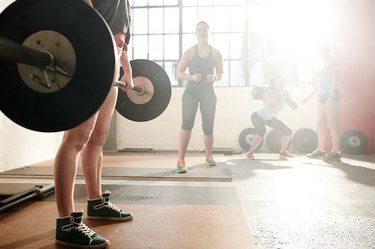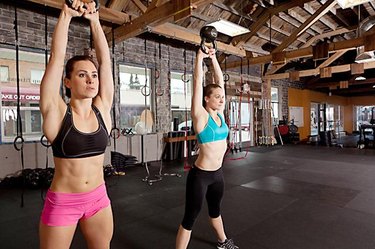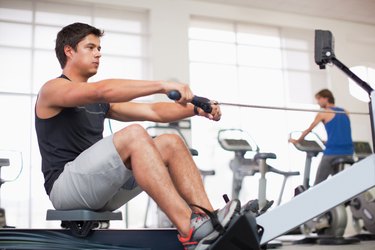
You have more than 600 skeletal muscles in your body. Can you name them all? Don't sweat it. Most men focus on three: guns, pecs and abs. And women? Butt, arms and tummy.
That's too bad, because the muscles you're missing can relieve pain, lower your injury risk, improve your posture, and improve your overall performance.
Video of the Day
Video of the Day
"[By ignoring these muscles], you hold yourself back. You're creating a weak link in the chain," says Shawn Arent, Ph.D., associate professor of exercise science at Rutgers University. These muscles may not be "showy," but training them can help raise your overall results. "You'll get stronger more quickly. And you'll be able to train, pain-free, for a lot longer."
So stop ignoring and use the following guide to hitting all five in your next workout. Your body will thank you (and the results will show).
1. Train Your Lower Trapezius
But you're hitting your trapezius with shrugs, right? Not as much as you think: Those "I dunno" movements target your upper trapezius -- the part by your neck you can see -- but don't fully engage your lower traps.
When your upper traps are overworked compared to your lower traps, your shoulders can roll forward, causing poor posture, as well as two other serious issues, says Aaron Brooks, a biomechanics expert and owner of Perfect Postures in Auburndale, Mass.
"One is cervical (neck) tension or pain, and the second is rotator cuff injury," he says. Either one of these, or both, means discomfort and a lack of mobility in a number of everyday situations. "It's going to affect you if you try to reach behind you, give you pain when you're putting on a jacket, or when you're reaching up to a cupboard to grab a dish."
How does this happen? "If your lower traps fire better, it'll put your shoulder in a better position to push more," says Mike Wunsch, performance director at Results Fitness in Santa Clarita, CA. When your upper and lower trap are imbalanced, your shoulder blade lifts off the spine, wreaking havoc on the shoulder, and causing space that can create rotator cuff impingement. Fixing the balance "undoes the traffic jam."
In addition, underdeveloped lower traps can affect the performance of your lats, pecs, and biceps, says Brooks. How? This is one instance where working as a team is a bad thing – which is exactly how these muscles are working if you have under-conditioned lower traps. These muscles work properly as antagonists to one another, so if they can't do that, you can't train them right.
How to Train the Trapezius
Wunsch has clients train the lower traps during warmups or between sets with Y, T, W, and I raises. These can be done on a Swiss ball, bench, or even on the floor, and with minimal or no weights. To do them on the floor, lie facedown and start with your arms straight so that your arms and body form a "Y" shape. Make a thumbs-up with your hands, so that your thumbs point to the ceiling. Keeping your arms straight and in the Y shape, lift your arms up off the ground (but not your head and neck), and slowly return to start. Repeat 5 to 10 times, and then do T raises.
T-RAISE: Start as you did for the Y raise, but with your arms out to the sides so your body forms a T. Again with thumbs up, raise and lower your arms 5 to 10 times.
W RAISE: Bend your arms at the elbows so that you form a W shape. Squeeze your shoulder blades together to bring your elbows up off the ground and towards one another. Repeat 5 to 10 times.
I RAISE: Straighten your arms again and point them straight over your head, so your body forms a straight line, like a capital I. With thumbs up, raise your arms as you did for the Y and T raises. Repeat 5 to 10 times.
2. Train Your Hamstrings and Work That Booty

We all love our quads. Why? It doesn't take much to work them.
"You're always activating your quads with normal, daily things. When you walk up stairs, when you squat … your quad activation is through the roof," says Bret Contreras, C.S.C.S., an Arizona-based strength coach and author known as "The Glute Guy". "Glute activation doesn't get that high, so the glutes stay weak."
We also tend to compensate in compound movements--those that use both quads and hamstrings--so that our quads work more, and the glutes and hamstrings weaken further. The result: "It puts more loading on the knee than on the hip joint, so people don't use their hips," he says.
Therein lies the solution, Contreras says: "You've got to do specific glute exercises, yes, but also lighten the load so you learn to perform them in a more hip-dominant fashion."
How to Train the Hamstrings and Booty
Contreras suggests starting with barbell hip thrusts and kettlebell swings.
BARBELL HIP THRUST: Sit on the ground with your shoulders against a bench. Bend your knees 90 degrees so that your feet are flat on the floor close to your butt, and your butt is on the floor, a light barbell across your waist. From here, squeeze your glutes to bridge up, using the bench to brace your shoulders, thrusting your hips to the sky. At the top of the move, your body should be straight from your neck to your knees. Return to start, and repeat.
KETTLEBELL SWINGS: Stand holding a kettlebell in front of you with two hands. Space your feet slightly wider than shoulder-width. Quickly, but in a controlled manner, swing the bell back between your legs, maintaining a flat back, then swing it up by raising your upper body and extending your hips. Each back and forth swing is one rep.
For hamstrings, Arent adds barbell good mornings, stability ball glute bridges, and the Swiss ball hip extension and leg curl. To perform this last move, lie on your back with your lower legs on a Swiss ball. Extend your arms to the sides and brace your palms on the floor. Squeeze your glutes to raise your hips so your body is straight from shoulders to knees. Pull your heels in and roll the ball towards your butt. Pause, then roll your heels back out. Drop your butt and hips to the ground, and repeat.
The best part? Because your quads are always getting stronger, you almost can't overtrain these antagonist muscles, Contreras says.
"Think about sprinters, gymnasts, even West Side powerlifters -- they're doing back raises on their off days from squats and deadlifts," he says. "You can train the glutes every single day."
4. Hit the Butt Muscles You DON'T See (Gluteus Medius)
There's more to your butt than the cheek. While you may be trying to hit your gluteus maximus, your gluteus medius is usually ignored. And that can wreck your knees.
"The glute medius prevents your knees from caving in when you're squatting and lunging and deadlifting," says Wunsch. This can cause ACL injuries and knee pain, as well as affect other parts of your lower body. "When your knee caves in, your femur internally rotates, and the inside of your knee gets strained. As a result, your foot arch can wind up collapsing. It's a cascading effect."
And if you fix it? You'll help protect from ACL injury, but also "you'll be able to lift more weight," Wunsch says, "and if you're a runner, you'll run farther without pain."
How to Train the Gluteus Medius
Wunsch suggests lateral band walks, quadruped fire hydrants, and side-lying clamshells.
LATERAL BAND WALK: Wrap a thick rubber resistance band (one that's a loop, without handles) around your ankles. Stand tall with knees slightly bent, and step to the right laterally, as if you were shuffling. Walk 10 steps to the right, then 10 back to the left.
FIRE HYDRANTS: Get on your hands and knees, with your hands directly beneath your shoulders, knees directly beneath your hips, and back flat. Keeping your back flat and knee bent, lift your right knee out to the right, as if you were a dog at a fire hydrant. Keep lifting your leg until your thigh is parallel to the floor. Return to the start, and repeat on the other side. Perform 10 reps on each side.
SIDE-LYING CLAMSHELL: Lie on your side on the floor, with your hips and knees bent 45 degrees, almost like a fetal position. Keeping your feet touching, raise your top knee as high as you can without moving your pelvis (as the name suggests, your legs should resemble a clamshell that's opening). Pause, and return to start. Repeat for 10 reps, then flip over and try it on the other side.
4. Train Your Whole Back

The middle of your back troubles Nick Tumminello.
"Everyone -- even fitness people -- are sitting more than ever, and these muscles are put at length," says Nick Tumminello, a strength and conditioning coach in Florida and the creator of DVDs including Strength Training for Fat Loss & Conditioning. "They don't get concentric shortening, especially under load, to keep them active and keep them strong."
These mid-back muscles are involved whenever you do a rowing exercise, but they're often not used to their full capacity, Tumminello says.
How to Train Your Whole Back
To make sure you're actually working this part of the back, slow down horizontal rowing movements to reduce bounce, and try the wide-grip overhand barbell bent-over row. Pick up the bar as if you were performing a normal barbell row, but hold your hands wide -- as wide as you would if you were performing a wide-grip pushup. Bend at the hips and lower as if you were performing a stiff-leg deadlift, maintaining a flat back. In this position, bend your elbows to pull the bar up until it touches your chest. Lower with control, and repeat for 10 reps.
5. Train Your Hips and Relieve Lower Back Pain
Your hips aren't just the side of your waist: The muscles flexing your leg at the pelvis wrap from your spine around your back through your core to the femur, and two of them -- collectively known as the iliopsoas (pronounced ILL-ee-oh-SO-as) -- get short, tight and weak, says Brooks.
As with several muscles mentioned above, these problems are created (or at least aggravated) by how much we sit and slouch. There's a direct correlation between the tightness in the psoas (one part of the iliopsoas) and low back pain: The muscle is connected to your 12th vertebra and deep tissue inside your hip.
How to Train Your Hips
To reduce this tightness and shortness, and the pain that comes with it, Brooks says to start by moving around more -- get up and walk around as often as you can. Also, when you're sitting, try this exercise twice each day: Sit up tall so your pelvis is tilted correctly and you're on your sit bones. Staying in this position, lift one foot off the floor, keeping your knee bent as you do. Return it to the floor, and repeat 10 times. Then switch to the other leg.